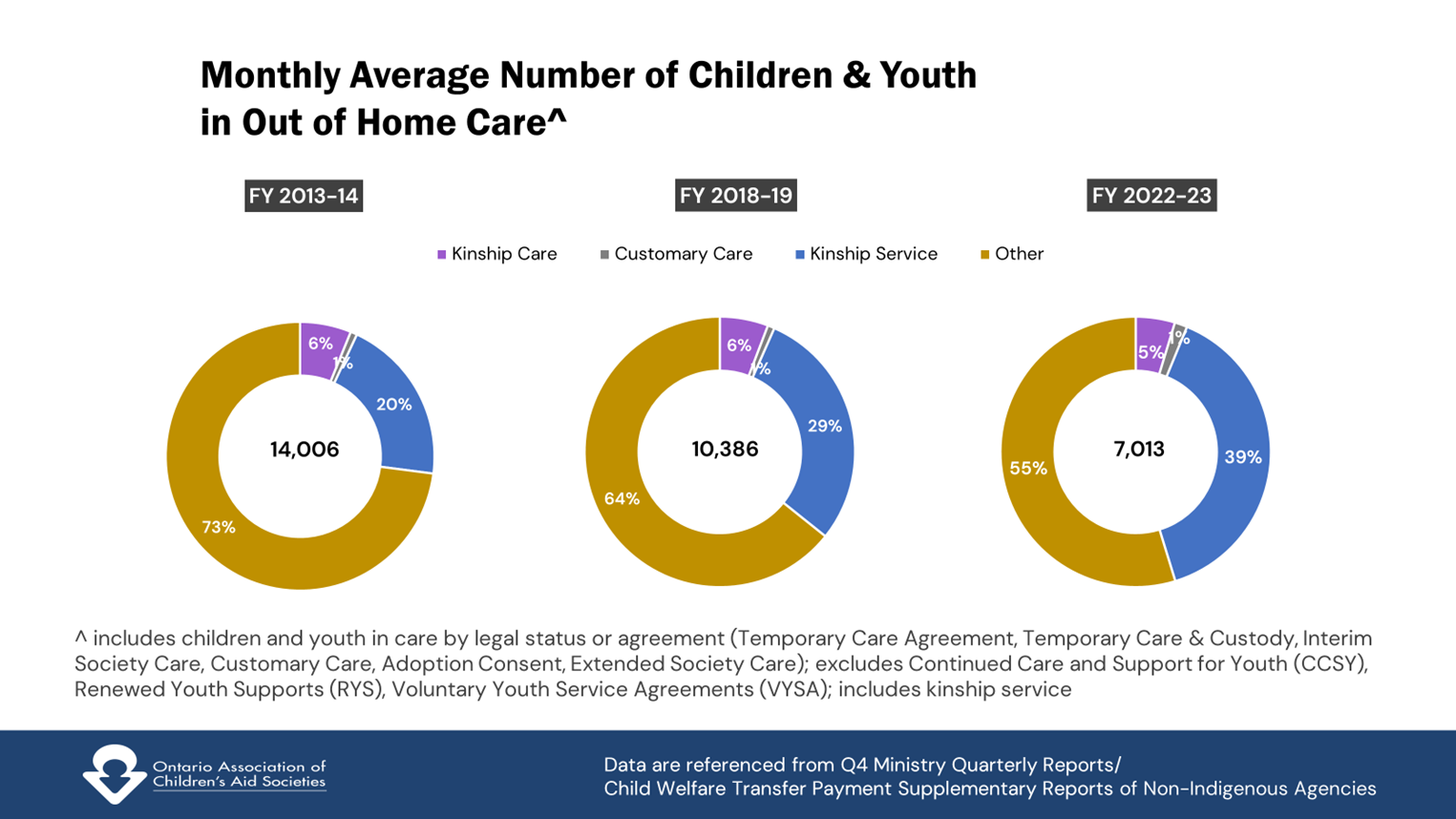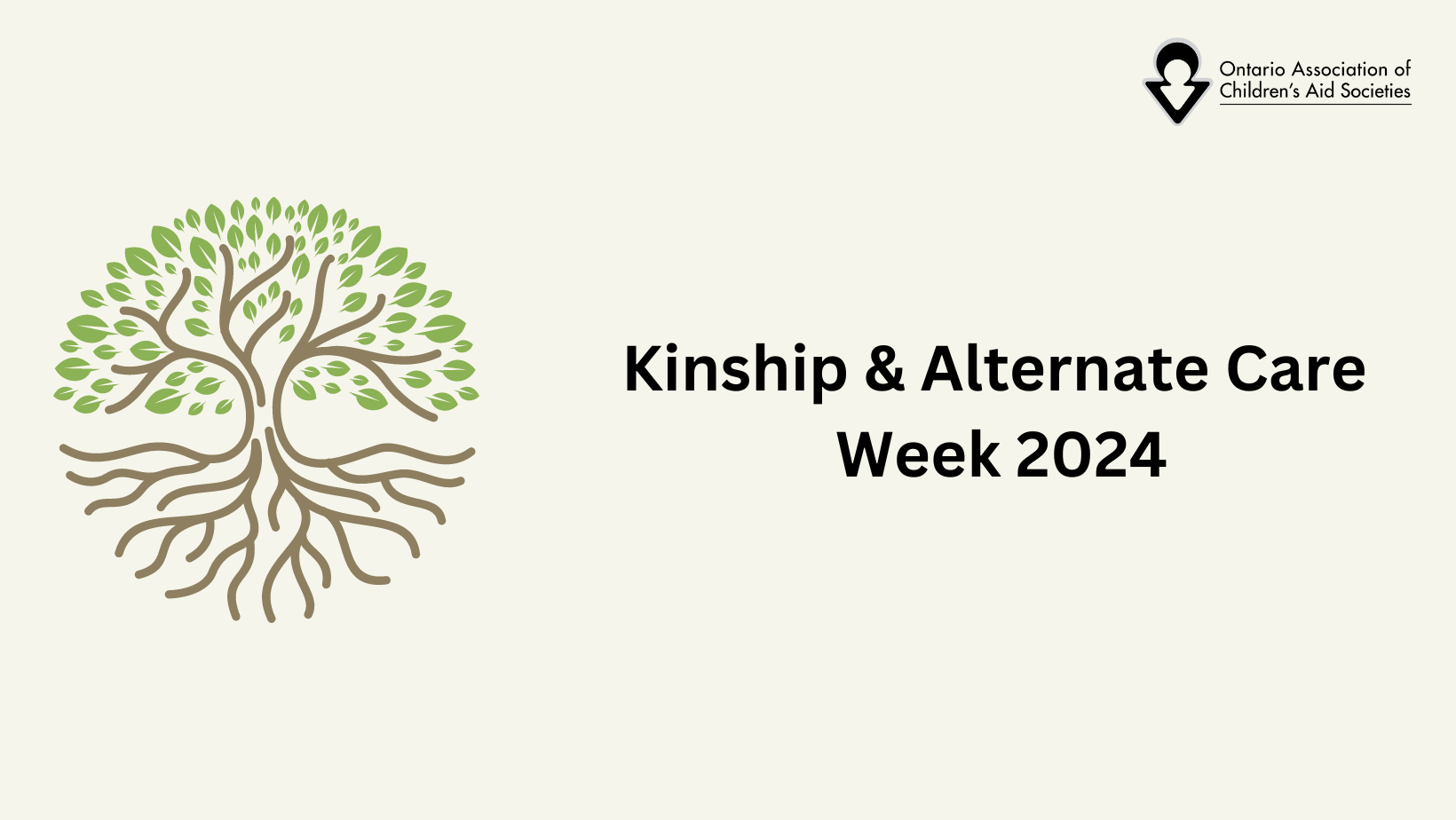“Kin and alternate caregivers are central to improving outcomes for children, youth, and families in Ontario’s child welfare system. Kin and alternate caregivers work in partnership with child welfare agencies to keep children, youth, families and communities connected. Over the past ten years, with the support of kin and alternate caregivers, our sector has seen an increase in children and youth remaining with their families and communities. This week, and always, we appreciate the crucial role of kin and alternate caregivers in supporting the well-being of children, youth, and families in Ontario.” – Solomon Owoo, Interim CEO, OACAS
September 16 to 20, 2024 is Kinship & Alternate Care Awareness Week, when children’s aid societies and Indigenous Child and Family Well-Being Agencies (child welfare agencies) recognize and build awareness about the important role of kin and alternate caregivers. But who are kin and alternate caregivers, what is their role, how do they work with child welfare agencies, what supports are available to them, and what is their impact? Learn more below.
Who are kin and alternate caregivers?
Kin are individuals who have a relationship with a child, youth, or family. This may include biologically related kin, members of cultural communities, or individuals with other social, emotional, or community connections, such as teachers, coaches, or neighbours.
Alternate caregivers are relatives or community members who provide living arrangements for children and youth when necessary. It is an inclusive term used by many child welfare agencies to describe the individuals who sometimes partner with child welfare agencies to provide family- and community-based placement options, such as kin service, kin care, and customary care.
What is customary care and why is it important?
Customary care is an inherent right and practice that predates the evolution of child welfare on Turtle Island and supersedes jurisdiction. Indigenous worldviews see children and youth at the centre of circles of care. Their family and community members work together to provide care according to the customs and traditions of their bands or Indigenous communities.
The overrepresentation of First Nations, Inuit, and Métis children, youth and families in Ontario’s child welfare system today is a direct result of Canada’s colonial history and disruptions in traditional care practices. Ongoing colonialism, systemic anti-Indigenous racism, and intergenerational trauma are at the root of the challenges that Indigenous families and communities are facing. To learn more about the history and practice of customary care, view the guide Our Children Are Our Gifts: A Best Practices Guide on Customary Care Processes in Ontario prepared by the Association of Native Child and Family Services Agencies of Ontario (ANCFSAO).
Working in partnership with kin and alternate caregivers in customary care arrangements is a vital part of the Ontario child welfare sector’s nine key commitments to reduce the number of Indigenous children and youth in care and advance reconciliation in the child welfare sector. The use of customary care arrangements allows children and youth to remain connected to their families and communities and ensure a strong sense of identity, culture, and belonging.
What is the role of kin and alternate caregivers?
Kin and alternate caregivers play a vital role in supporting children, youth, and families and improving outcomes. Maintaining broad kin networks is directly linked to better outcomes and positively contributes to the well-being of children, youth, and families involved with the child welfare system. The involvement of kin and alternate caregivers early and throughout child welfare planning increases safety and well-being and helps ensure children and youth can remain in their own homes, with their families, and in their communities. Their involvement can also promote family reunification. In some circumstances, kin and alternate caregivers welcome a child or young person into their home to offer family- and community-based out-of-home care placements.
How do kin and child welfare agencies work together?
Some families face issues like poverty, inadequate housing, unemployment, mental health and addictions, as well as intersecting systems of power, privilege, and oppression. Indigenous and Black communities face anti-Indigenous racism and anti-Black racism across sectors and over-surveillance, over-policing, and over-reporting. These issues can lead to stressors and challenges. When facing such challenges, kin and alternate caregivers support their loved ones and community members alongside their local child welfare agency.
In 97% of investigations by a child welfare agency, children and youth remain at home, and their families may receive early intervention and prevention supports and services so they can thrive and stay together. When it is not possible for children and youth to remain at home, kin and alternate caregivers coordinate out-of-home care with the child welfare agency. Most children and youth receiving out-of-home care are placed in kinship service or customary care (2% of investigations) and fewer are placed in kinship care or other placement types (1% of investigations). (Source: Ontario Incidence Study, 2018)
Data regarding ten-year trends in child welfare shows a 19% increase in the proportion of children and youth in out-of-home care being placed with kin and alternate caregivers.

These trends fit with child welfare redesign, improvements with family search and engagement, child welfare sector’s nine Reconciliation Commitments, the Truth and Reconciliation Commission of Canada’s Calls to Action, the One Vision One Voice Race Equity Practices, and legislative obligations.
How do child welfare agencies support kinship and alternate caregivers?
Kin and alternate caregivers supporting the children, youth and families in their lives is not a new practice; it is a long-held tradition that cuts across generations and cultures.
The Kinship Service Standards (the Standards) reflect this reality. The Standards recognize that “it is common in many communities for children to either live temporarily or to be raised in kinship living arrangements,” and that kin and alternate caregivers offer “care and support that is consistent with family and community traditions.” Though kin and alternate caregivers do not always require support from their local child welfare agency when caring for members of their family or community, the Standards must be considered when child welfare agencies become involved.
Child welfare agencies can support kinship and alternate care in different and creative ways through a variety of funded placement options (i.e., kin service, kin care, subsidized customary care). Direct service staff provide information about options that centre the unique needs, strengths, and circumstances of the child and youth, as well as their caregivers. At some agencies, this work is supported by kinship and alternate care departments that offer information and advice. Determining an appropriate level of support and service from the onset to ensure the placement is adequately resourced is a critical part of promoting sustainable out-of-home care.
What is the impact of kin and alternate caregivers?
Kin and alternate caregivers keep children and youth connected to their families and communities and help ensure children and youth continue to have a strong sense of identity, culture, and belonging.
All aspects of identity (i.e., race, culture, sexual orientation, gender identity and expression) are critical to service planning. Through family- and community-based placements with kin and alternate caregivers, children and youth can maintain cultural and community connections that ensure they receive inclusive, identity-affirming care and help them thrive.
Kin and alternate caregivers play an essential role in the work to deliver improved, equitable outcomes for children, youth, and families overrepresented in the child welfare system and facing disparities in outcomes. This includes Indigenous, Black, racialized, and 2SLGBTQ+ children and youth.
Why do we recognize kin and alternate caregivers in September?
Kin and alternate caregivers provide essential support to children, youth, and families in Ontario. They deserve to be recognized and thanked for the important role they play in safeguarding the health, safety, and well-being of children and youth, as well as their families and communities. OACAS and our member child welfare agencies are grateful for kin and alternate caregivers and are committed to supporting them to ensure they have the supports and services they need.
What additional resources are available to learn more about kinship and alternate care?
For more resources about kinship and child welfare, visit the Kinship and Alternate Care Library Guide, or read this post exploring the intersections of reconciliation, equity, and kinship and alternate care or this one detailing the resources kin and alternate care need to be adequately supported in their role.
